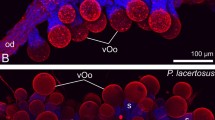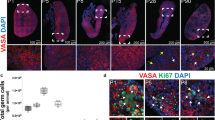Abstract
IN most Eutherian mammals oogenesis, that is, mitotic proliferation of oogonia followed by the formation of oocytes in the arrested diplotene stage of meiosis, occurs only during embryonic life or the first weeks of postnatal life1. Certain prosimians seem to be exceptions to this general rule. Some fifty years ago Gérard2 described germinal cords, containing oogonia and oocytes in the prophase of meiosis, in the ovarian cortex of an adult greater galago (Galago crassicaudatus). Similar histological appearances have been described since then in several other species3. Electron microscopic preparations from the ovarian cortex of an adult Senegal galago (Galago senegalensis senegalensis) show that the germinal cords contain large round cells which have all the ultra-structural features of oogonia seen in mammalian embryos during the period of oogenesis. Some of the cells have synaptinemal cores in their nuclei indicating that they are oocytes in the zygotene/pachytene stage of meiosis4. Metaphase figures are rarely seen in the germinal cords, and it is difficult to be certain whether they are in the oogonia or the pre-granulosa cells. It is maintained that the only acceptable histological evidence of neoformation of germ cells in the adult mammalian ovary would be the observation of mitotic divisions in oogonia1. But if such newly formed oogonia add to the total stock of oocytes it is also necessary to show that some enter the prophase of meiosis and form primordial follicles containing oocytes in arrested diplotene. The only reported attempt to investigate DNA synthesis in the cells of the germinal cords in an adult prosimian is that of Ioannu5. Twenty-four hours after the injection of 3H-thymidine into adult specimens of Demidoff's galago (Galagoides demidoffi) labelled cells were found in the germinal cords. They were considered to be either oogonia in mitotic prophase or oocytes in pre-leptotene or leptotene stages of meiosis. This scanty evidence was interpreted as indicating the occurrence of active oogenesis.
This is a preview of subscription content, access via your institution
Access options
Subscribe to this journal
Receive 51 print issues and online access
$199.00 per year
only $3.90 per issue
Buy this article
- Purchase on Springer Link
- Instant access to full article PDF
Prices may be subject to local taxes which are calculated during checkout
Similar content being viewed by others
References
Franchi, L. L., Mandl, A. H., and Zuckerman, S., The Ovary, 1, 1, 88 (Academic Press, New York and London, 1962).
Gérard, P., Arch. Biol., 30, 357 (1920).
Duke, K. L., Folia Primat., 7, 150 (1967).
Butler, H., Proc. Second Internat. Primatological Conf., Atlanta, 1966 (in the press).
Ioannu, J. M., J. Embryol. Exp. Morph., 17, 139 (1968).
Beaumont, H. M., and Mandl, A. H., Proc. Roy. Soc., B, 155, 557 (1962).
Author information
Authors and Affiliations
Rights and permissions
About this article
Cite this article
BUTLER, H., JUMA, M. Oogenesis in an Adult Prosimian. Nature 226, 552–553 (1970). https://doi.org/10.1038/226552a0
Received:
Issue Date:
DOI: https://doi.org/10.1038/226552a0
This article is cited by
Comments
By submitting a comment you agree to abide by our Terms and Community Guidelines. If you find something abusive or that does not comply with our terms or guidelines please flag it as inappropriate.



